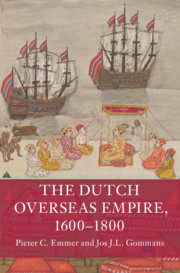Book contents
- The Dutch Overseas Empire, 1600–1800
- Additional material
- The Dutch Overseas Empire, 1600–1800
- Copyright page
- Contents
- Figures
- Cover Image
- Maps
- Note on Terminology
- Preface
- Frontispiece
- Introduction
- Part I The Grumbling Hive
- Part II The Atlantic World
- Part III Monsoon Asia
- Introduction
- 7 The Dutch Tropics
- 8 The Indian Ocean
- 9 The South China Sea
- Conclusion
- Coda
- References
- Index
Introduction
from Part III - Monsoon Asia
Published online by Cambridge University Press: 29 September 2020
- The Dutch Overseas Empire, 1600–1800
- Additional material
- The Dutch Overseas Empire, 1600–1800
- Copyright page
- Contents
- Figures
- Cover Image
- Maps
- Note on Terminology
- Preface
- Frontispiece
- Introduction
- Part I The Grumbling Hive
- Part II The Atlantic World
- Part III Monsoon Asia
- Introduction
- 7 The Dutch Tropics
- 8 The Indian Ocean
- 9 The South China Sea
- Conclusion
- Coda
- References
- Index
Summary
Any analysis of Dutch expansion under the VOC would be impossible without first properly sketching out the geographical conditions to the east of the Cape of Good Hope. Modern categories of ‘Europe’ and ‘Asia’ are hardly suited for this purpose. Similar terms such as ‘the West’ or ‘the Orient’ are equally inadequate as a reference framework for a historical treatment of early Dutch expansion history after Vasco da Gama’s revolutionary discovery of the Cape route. It was not until the nineteenth century that such sharp dichotomies gained the upper hand in the explanatory models for colonial dominance and the economic rise of Western Europe. Besides the objection that these terms are something of an anachronism, the categories ‘Europe’ and ‘Asia’ are far too general, and they fail to do justice to both the diversity within and the continuity between these two regions.
- Type
- Chapter
- Information
- The Dutch Overseas Empire, 1600–1800 , pp. 246 - 253Publisher: Cambridge University PressPrint publication year: 2020

